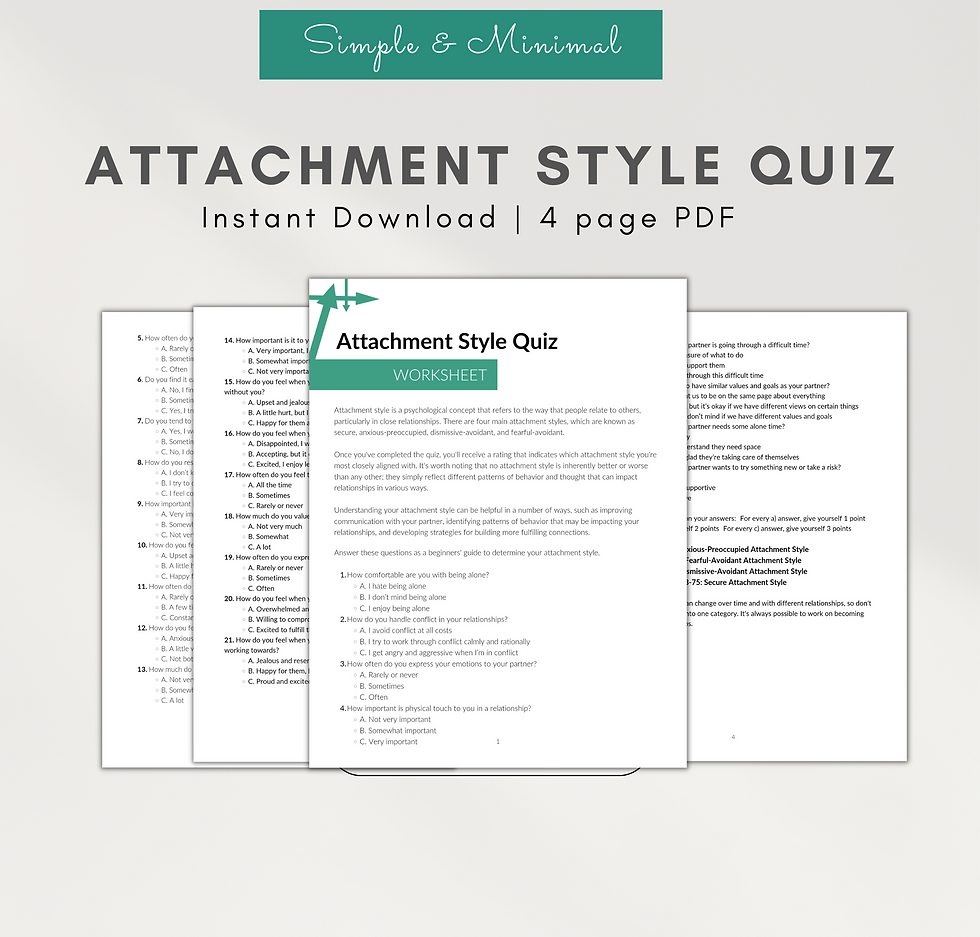Attachment Style Quiz - Learning your Attachment Style
- Jul 31, 2023
- 3 min read
Updated: Aug 1, 2023

Understanding the attachment style theory
Attachment style theory is a psychological framework that seeks to understand how individuals form and maintain relationships. John Bowlby first proposed it in the 1950s and has since been expanded upon by various researchers, such as Mary Ainsworth. The theory suggests that early experiences with caregivers shape an individual's attachment style, influencing their behavior and expectations in future relationships.
The attachment style theory can be applied to people of all ages. Understanding one's attachment style can help individuals navigate their relationships more effectively and make positive changes to their attachment patterns.
An attachment style is a specific pattern of behavior in and around relationships, and there are four main adult attachment styles: secure attachment, anxious-preoccupied attachment, dismissive-avoidant attachment, and fearful-avoidant attachment.
Secure attachment is characterized by individuals who have a positive view of themselves and their relationships, and they are generally able to effectively communicate their needs and emotions. They are confident that their partners will be there for them when they need them, and they are comfortable with both intimacy and independence.
Anxious-preoccupied attachment is characterized by individuals who have a strong desire for closeness and intimacy but also experience high levels of anxiety and insecurity in relationships. They often worry about abandonment and seek reassurance from their partner. They often have a hard time trusting that their partner is committed to the relationship.
Dismissive-avoidant attachment is characterized by individuals who are uncomfortable with intimacy and tend to avoid emotional closeness in relationships. They often have a dismissive attitude towards relationships and may prioritize independence over emotional connection. They may come across as emotionally distant or detached and often prefer to be independent and self-reliant. They might believe that they don't need anyone else and can handle things on their own.
Fearful-avoidant attachment, also known as disorganized attachment, is characterized by individuals who have conflicting desires for closeness and distance. These individuals have a combination of anxious and avoidant tendencies. They desire closeness but also fear rejection and may struggle with maintaining stable and secure relationships. They are also afraid of getting close to others because they fear being hurt, but they also fear being alone. They may have a hard time trusting others and often struggle with emotional intimacy.
The target audience of the attachment style theory
The attachment style theory is designed for individuals in relationships, regardless of whether they are romantic or non-romantic in nature. According to the field of attachment theory, each person has a unique attachment style that influences how they relate to intimacy.
Is the attachment style quiz accurate?
Many people are curious about their own attachment style and may turn to attachment-style quizzes for insight. However, it's essential to approach these quizzes with mindfulness. While they can provide some general information and self-reflection, they should not be seen as definitive or diagnostic. These quizzes only aim to help individuals understand their attachment style and how it may impact their relationships.
An attachment style quiz can be a helpful tool in determining one's attachment style. These quizzes are designed to provide individuals with insights into their tendencies and patterns of connecting with others. They typically assess various aspects of attachment, such as the level of security, anxiety, avoidance, or dependence in relationships. While these quizzes can be informative, it is important to note that they may not always provide a completely accurate representation of an individual's attachment style. Attachment styles can be complex and may vary across different relationships and contexts. Therefore, it is recommended to use the quiz results as a starting point for self-reflection and exploration rather than a definitive diagnosis.



Changing attachment style
If an individual wishes to change their attachment style, it is possible with self-awareness, personal growth, and therapeutic interventions. Developing a secure attachment style, which is characterized by trust, emotional availability, and effective communication, can lead to healthier and more fulfilling relationships. Changing attachment patterns often involves examining and addressing underlying beliefs, emotions, and behaviors that contribute to insecure attachment. Seeking support from a qualified therapist or counselor who specializes in attachment theory can provide guidance and strategies for developing a more secure attachment style. Additionally, engaging in self-reflection, practicing mindfulness, and learning healthy relationship skills can also contribute to positive changes in attachment patterns.

Comments